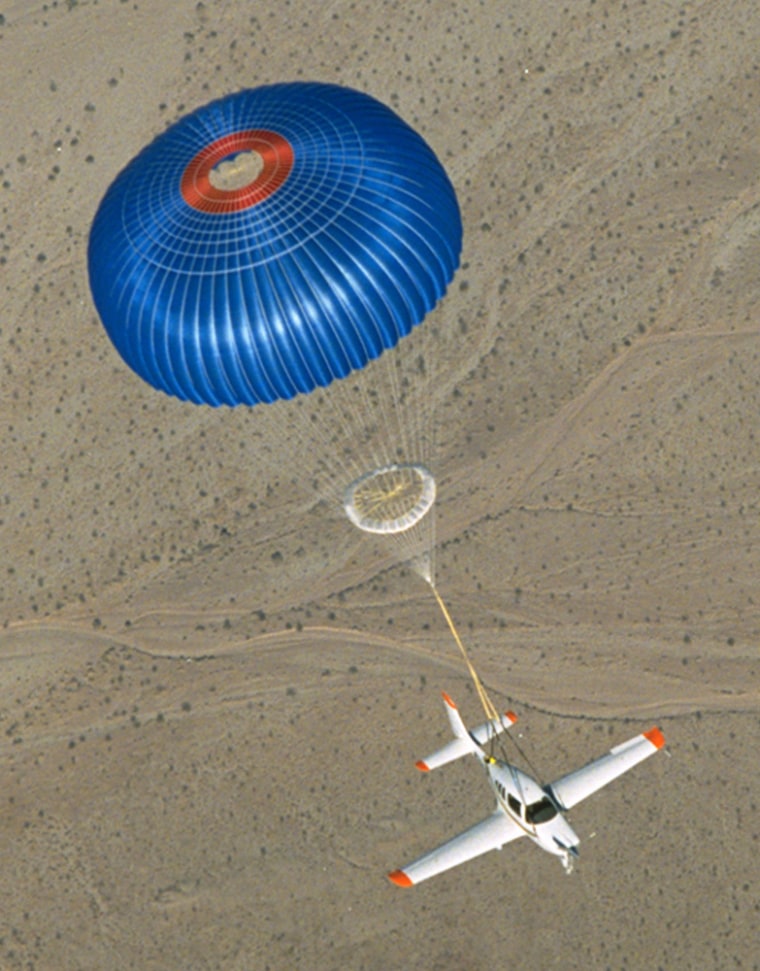Albert Kolk's small plane banked uncontrollably in darkness over the Monashee mountains, then began spiraling. "Seat belts!" he barked to his teenage grandson and two young friends. Then he reached for a red lever in the cockpit. Suddenly, an orange-and-white parachute as big as a house opened above the plane and gently landed his stricken aircraft in a rocky clearing.
If the maker of the parachute that saved Kolk's life this past spring succeeds, one day commercial aircraft like regional commuter jets may have similar safety systems. First, though, there's the challenge of creating a parachute robust enough to rescue bigger, faster planes.
"Weight and speed are always the challenge," acknowledged Robert Nelson, chairman of Ballistic Recovery Systems Inc., which sold about 500 of its $16,000 parachute systems this year for use by small private planes and pilots like Kolk.
The company's most advanced parachute right now can accommodate nearly 4,000 pounds. While small planes can weigh up to 2,000 pounds and cruise about 175 miles per hour, regional jets weigh 80,000 pounds and fly at more than 600 miles per hour.
That's why Ballistic Recovery Systems is working with NASA — which gave it $670,000 for research — to design a new generation of emergency parachutes that would work on small jets and could be steered by pilots as they drift to the ground.
Kolk, a rancher who was piloting his private plane April 8 from Seattle to his ranch in British Columbia, remembered reaching for the parachute handle as his plane slipped into a dangerous flat spin over the mountains in British Columbia, "like how a dog chases its tail."
A seasoned pilot, Kolk said he had never experienced such a disaster in over a decade of private flying. "I knew I was in trouble. I couldn't straighten out," Kolk said. "When that chute opened, it was a peaceful, wonderful feeling."
Kolk's experience is one of four cases where parachute-equipped planes landed safely beneath a canopy since U.S. regulators approved the system six years ago. Ballistic Recovery Systems, based in St. Paul, Minn., says eight lives were saved in those four incidents, plus dozens of other people in accidents involving smaller parachute-equipped ultralight planes that resemble motorized gliders.
The parachute, stored behind the rear seats in small planes, is fired with a rocket through the rear windshield; it's attached with high-strength lines to the plane's wings, nose and tail.
They are increasingly popular among private pilots, and for good reason: The government said 626 people died in general aviation crashes in 2003, compared with 81 people aboard commercial airlines.
Aviation experts question whether parachutes will ever be attached to the largest passenger jets, such as the Boeing 747, which weighs more than 900,000 pounds. "The speed and weight of those planes would seem to preclude a system like that," said James Hall, former chairman of the National Transportation Safety Board.
Most of the estimated 500 parachute systems Ballistic Recovery Systems sold in 2004 went to aircraft manufacturer Cirrus Design Corp. of Duluth, Minn., which includes them as standard equipment on its line of small private planes. U.S. regulations allow owners of some Cessna small planes to install parachutes, but only about a dozen have bought the add-on equipment so far.
Brent Brown, a lawyer in Roanoke, Va., was having one added to his plane. Brown, who often flies twice a week over the mountains in western Virginia, said he couldn't imagine choosing to save money by not adding the new safety equipment. "I would feel awful silly on that terrible, terrible ride down," Brown said.
When systems fail
The emergency parachutes aren't flawless. Two families in Syracuse, N.Y., are suing Cirrus, Ballistic Recovery Systems and others for a combined $67.5 million over a fatal crash in April 2002. The case is pending in federal court.
The families said the pilot, a plastic surgeon who bought the plane six days earlier, tried to open the parachute but it failed. Defense lawyers have denied the system malfunctioned, and federal investigators concluded the parachute never opened "for undetermined reasons."
In another accident, one month before the Syracuse crash, pilot Paul Heflin of Lexington, Ky., repeatedly pulled hard on the parachute handle when his plane began a steep, uncontrolled dive from 3,000 feet. "He was pulling for his life," recalled Heflin's passenger, Benjamin Ditty. Both suffered minor injuries but walked away from the wreckage.
The parachute popped open just after the plane crashed, "which was not too convenient for us," Ditty said. Months after Heflin's crash, Cirrus ordered all its customers to immediately replace a vital cable in the parachute system.
Heflin said he still has faith in the parachute, but Ditty — who also flies — said he would never rely on one again. "It was supposed to work," he said.
Some pilots insist they'll never fly without a parachute. "People are crazy not to fly with them," said William Graham of San Diego, an instructor pilot whose plane landed beneath a parachute this spring near Stockton, Calif., after it unexpectedly flipped upside down at 16,000 feet. Graham, who was flying with his wife, Barbara, said they drifted onto a farm field so gently the landing didn't break fragile Christmas ornaments and glass bottles aboard the plane.
